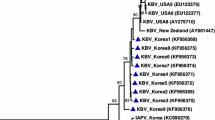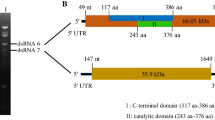Abstract
Chronic bee paralysis virus (CBPV) is an important viral pathogen that affects adult bees. Although several CBPV strains have been reported, little information has been obtained from China. In this study, two major segments of the CBPV Chinese isolate CBPV-BJ, RNA 1 and RNA 2, were determined to be 3657 and 2267 nucleotides (nt) in length, respectively. RNA 1 and RNA 2 contained three and four open reading frames (ORFs), respectively, which agreed with known reference strains (EU122229 and EU122230). The RNA 1 had 98% nucleotide sequence identity to a known Chinese strain (KU950353), and RNA 2 had 97% nucleotide sequence identity to another Chinese strain (KU950354). Although the lengths of the RNA 1 and RNA 2 sequences were 17 nt and 38 nt shorter than those of the CBPV reference strains EU122229 and EU122230, respectively, the complete CBPV-BJ RNA 1 and RNA 2 sequences shared 91% and 92% identity with them. Phylogenetic analysis based on the sequences of the RNA-dependent RNA polymerase (RdRp) and putative structural proteins (pSPs) showed that CBPV-BJ was most closely related to the other two Chinese isolate (KU950353 and KU950354) and clustered with most Asian strains. These data provide new information that will lead to a better understanding of the diversity of the CBPV genome.


Similar content being viewed by others
References
van der Zee R, Pisa L, Andonov S, Brodschneider R, Charrière J-D, Chlebo R, Coffey MF, Crailsheim K, Dahle B, Gajda A, Gray A, Drazic MM, Higes M, Kauko L, Kence A, Kence M, Kezic N, Kiprijanovska H, Kralj J, Kristiansen P, Hernandez RM, Mutinelli F, Nguyen BK, Otten C, Özkırım A, Pernal SF, Peterson M, Ramsay G, Santrac V, Soroker V, Topolska G, Uzunov A, Vejsnæs F, Wei S, Wilkins S (2012) Managed honey bee colony losses in Canada, China, Europe, Israel and Turkey, for the winters of 2008–9 and 2009–10. J Apicul Res 51:100–114
Cornman RS, Tarpy DR, ChenYP Jeffreys L, Lopez D, Pettis JS, vanEngelsdorp D, Evans JD (2012) Pathogen webs in collapsing honey bee colonies. PLoS One 7:e43562
Brutscher LM, McMenamin AJ, Flenniken ML (2016) The buzz about honey bee viruses. PLoS Pathog 12:e1005757
Gisder S, Genersch E (2016) Viruses of commercialized insect pollinators. J Invertebr Pathol. doi:10.1016/j.jip.2016.07.010
Tehel A, Brown MJF, Paxton RJ (2016) Impact of managed honey bee viruses on wild bees. Curr Opin Virol 19:16–22
Bailey L, Gibbs AJ, Woods RD (1963) Two viruses from adult honey bees (Apis mellifera Linnaeus). Virology 21:390–395
Bailey L, Gibbs AJ, Woods RD (1968) The purification and properties of chronic bee-paralysis virus. J Gen Virol 2:251–260
Amiri E, Meixner M, Büchler R, Kryger P (2014) Chronic bee paralysis virus in honeybee queens: evaluating susceptibility and infection routes. Viruses 6:1188–1201
Berényi O, Bakonyi T, Derakhshifar I, Köglberger H, Nowotny N (2006) Occurrence of six honeybee viruses in diseased Austrian apiaries. Appl Environ Microb 72:2414–2420
Choe SE, Nguyen LTK, Noh JH, Koh HB, Jean YH, Kweon CH, Kang SW (2012) Prevalence and distribution of six bee viruses in Korean Apis cerana populations. J Invertebr Pathol 109:330–333
Olivier V, Blanchard P, Chaouch S, Lallemand P, Schurr F, Celle O, Dubois E, Tordo N, Thiéry R, Houlgatte R, Ribière M (2008) Molecular characterisation and phylogenetic analysis of chronic bee paralysis virus, a honey bee virus. Virus Res 132:59–68
Tentcheva D, Gauthier L, Zappulla N, Dainat B, Cousserans F, Colin ME, Bergoin M (2004) Prevalence and seasonal variations of six bee viruses in Apis mellifera L. and Varroa destructor mite populations in France. Appl Environ Microb 70:7185–7191
Chauzat MP, Jacques A, Epilobee consortium, Laurent M, Bougeard S, Hendrikx P, Ribière-Chabert M (2016) Risk indicators affecting honeybee colony survival in Europe: one year of surveillance. Apidologie 47:348–378
Blanchard P, Ribière M, Celle O, Lallemand P, Schurr F, Olivier V, Iscache AL, Faucon JP (2007) Evaluation of a real-time two-step RT-PCR assay for quantitation of chronic bee paralysis virus (CBPV) genome in experimentally-infected bee tissues and in life stages of a symptomatic colony. J Virol Methods 141:7–13
Ribiere M, Lallemand P-A, Schurr F, Celle O, Blanchard P, Olivier V, Faucon J (2007) Spread of infectious chronic bee paralysis virus by honeybee (Apis mellifera L.) feces. Appl Environ Microb 73:7711–7716
Toplak I, Jamnikar Ciglenecki U, Aronstein K, Gregorc A (2013) Chronic bee paralysis virus and Nosema ceranae experimental co-infection of winter honey bee workers (Apis mellifera L.). Viruses 5:2282
Laurent M, Bougeard S, Hendrikx P, Ribière-Chabert M, Chauzat MP (2012) A pan-European epidemiological study on honeybee colony losses 2012–2014. https://ec.europa.eu/food/sites/food/files/animals/docs/live-animals_bees_bee-report_2012_2014_en.pdf. Accessed 27 Aug 2014
Amiri E, Meixner M, Nielsen SL, Kryger P (2015) Four categories of viral infection describe the health status of honey bee colonies. PLoS One 10:e0140272
Welch A, Drummond F, Tewari S, Averill A, Burand JP (2009) Presence and prevalence of viruses in local and migratory honeybees (Apis mellifera) in Massachusetts. Appl Environ Microb 24:7862–7865
Ai HX, Yan X, Han RC (2012) Occurence and prevalence of seven bee viruses in Apis mellifera and Apis cerana apiaries in China. J Invertebr Pathol 109:160–164
Ding GL, Shi W (2015) Investigation of seven viruses in Apis cerana and Apis mellifera of China. Acta Vet Zootech Sin 10:1822–1828
Ellis JD, Munn PA (2006) The worldwide health status of honey bees. Bee World 86:88–101
de Miranda JR, Cordoni G, Budge G (2010) The acute bee paralysis virus–Kashmir bee virus–Israeli acute paralysis virus complex. J Invertebr Pathol 103(Supplement):S30–S47
Miranda JRD, Genersch E (2010) Deformed wing virus. J Invertebr Pathol 103(Suppl 1):S48–S61
Youssef I, Schurr F, Goulet A, Cougoule N, Ribière M, Darbon H, Thiéry R, Dubois E (2015) RNA 1 and RNA 2 genomic segment of chronic bee paralysis virus are infectious and induce chronic bee paralysis disease. J Immunol Res 2:262–270
Olivier V, Blanchard P, Chaouch S, Lallemand P, Schurr F, Celle O, Dubois E, Tordo N, Thiery R, Houlgatte R, Ribière M (2008) Molecular characterization and phylogenetic analysis of chronic bee paralysis virus, a honey bee virus. Virus Res 132:8
Rinderer TE, Green TJ (1976) Serological relationship between chronic bee paralysis virus and the virus causing hairless-black syndrome in the honeybee. J Invertebr Pathol 27:403–405
Acknowledgements
This work was supported by the National Natural Science Foundation of China (31572471) and the Agricultural Science and Technology Innovation Program (CAAS-ASTIP-2016-IAR).
Author information
Authors and Affiliations
Corresponding authors
Ethics declarations
Conflict of interest
The authors declare that they have no conflict of interest.
Ethical approval
This article does not contain any studies with human participants or animals performed by any of the authors.
Additional information
Chunsheng Hou and Qingyun Diao are co-corresponding authors.
Electronic supplementary material
Below is the link to the electronic supplementary material.
Rights and permissions
About this article
Cite this article
Li, B., Deng, S., Yang, D. et al. Complete sequences of the RNA 1 and RNA 2 segments of chronic bee paralysis virus strain CBPV-BJ detected in China. Arch Virol 162, 2451–2456 (2017). https://doi.org/10.1007/s00705-017-3373-6
Received:
Accepted:
Published:
Issue Date:
DOI: https://doi.org/10.1007/s00705-017-3373-6




